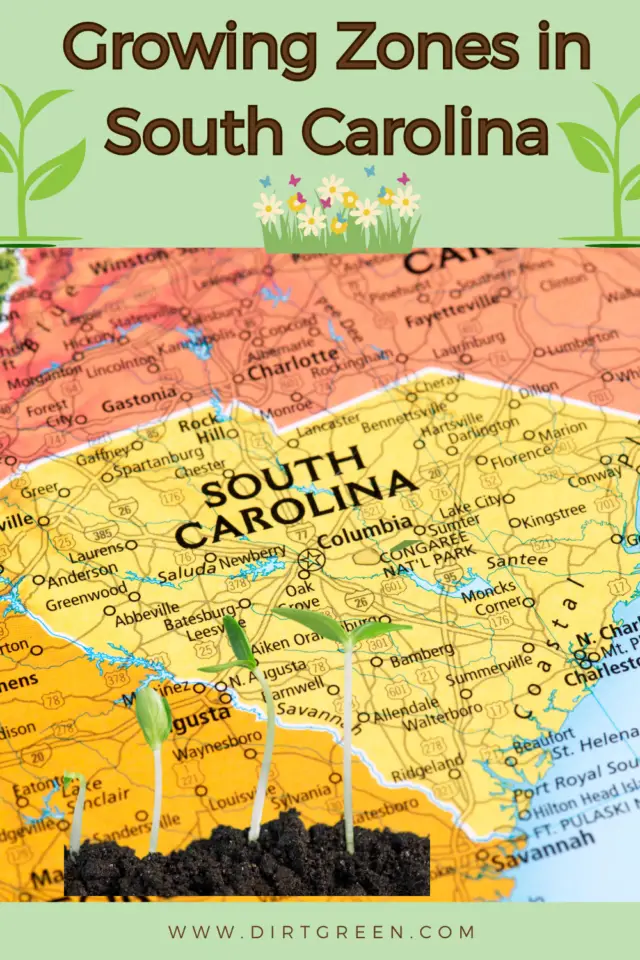Knowing your growing zone as a South Carolina gardener is essential to the success of your plants.
South Carolina’s diverse climate, ranging from the coastal regions to the upstate areas, offers a variety of growing conditions that can support a wide range of plants.
We will look at the many growth zones in South Carolina, their traits, and the plants that do well in each zone in this extensive guide.
Growing Zones

Growing Zones in South Carolina
Growing zones, also known as hardiness zones or plant hardiness zones, are geographic areas defined by the average annual minimum winter temperatures.
These zones help gardeners determine which plants are most likely to survive and thrive in a particular region.
The United States Department of Agriculture (USDA) has developed a Plant Hardiness Zone Map that divides the country into 13 zones based on average annual extreme minimum temperatures.
South Carolina’s Growing Zones
South Carolina spans multiple growing zones, with zones 7b, 8a, and 8b being the most prevalent. Let’s take a closer look at each of these zones and their unique characteristics.
Zone 7b: This zone covers a significant portion of the upstate region, including areas around Greenville, Spartanburg, and Anderson.
In zone 7b, the average annual minimum temperature ranges from 5°F to 10°F (-15°C to -12°C). Plants suitable for this zone should be able to withstand temperatures as low as 5°F (-15°C).
Zone 8a: This zone encompasses much of the central region of South Carolina, including parts of Columbia, Sumter, and Florence. The average annual minimum temperature in zone 8a ranges from 10°F to 15°F (-12°C to -9°C). Plants suitable for this zone should be able to tolerate temperatures as low as 10°F (-12°C).
Zone 8b: This zone covers the coastal regions of South Carolina, including areas around Charleston, Beaufort, and Hilton Head Island. In zone 8b, the average annual minimum temperature ranges from 15°F to 20°F (-9°C to -7°C). Plants suitable for this zone should be able to withstand temperatures as low as 15°F (-9°C).
It’s important to note that microclimates can exist within these larger growing zones, influenced by factors such as elevation, proximity to bodies of water, and urban heat islands. Therefore, it’s always a good idea to observe and monitor the specific conditions in your garden and adjust your plant selections accordingly.
Choosing Plants for Your Growing Zone
It is time to investigate the plants that do well in each of South Carolina’s growth zones now that you are aware of them. For each zone, consider these well-liked plant selections:
Zone 7b:
- Fruit Trees: Apple, Pear, Peach, Plum
- Vegetables: Broccoli, Cabbage, Carrots, Spinach
- Flowers: Daffodils, Peonies, Tulips, Irises
- Shrubs: Azaleas, Rhododendrons, Hydrangeas
Zone 8a:
- Fruit Trees: Citrus (Oranges, Lemons, Limes), Figs, Pomegranates
- Vegetables: Tomatoes, Peppers, Eggplants, Okra
- Flowers: Roses, Zinnias, Marigolds, Petunias
- Shrubs: Gardenias, Camellias, Crape Myrtles
Zone 8b:
- Fruit Trees: Avocados, Mangoes, Lychees
- Vegetables: Sweet Potatoes, Peanuts, Watermelons
- Flowers: Hibiscus, Bougainvillea, Plumeria
- Shrubs: Oleanders, Jasmine, Pittosporum
It is crucial to remember that these are only suggestions; while choosing plants for your garden, there can be other aspects to take into account, such as the type of soil, how much sun the plant receives, and how much water it needs.
Extending Your Growing Season
Even within the same growing zone, gardeners can take steps to extend their growing season and enjoy a wider variety of plants. Here are some tips for extending your growing season in South Carolina:
1). Use Season Extenders: Utilize season extenders like cold frames, greenhouses, or row covers to protect plants from extreme temperatures and extend their growing period.
2). Start Seeds Indoors: Begin your gardening season earlier by starting seeds indoors several weeks before the last expected frost date.
3). Choose Varieties Wisely: Select varieties of plants that are known for their early or late maturation, allowing you to harvest earlier or later in the season.
4). Succession Planting: Practice succession planting by staggering the planting times of your crops, ensuring a continuous harvest throughout the growing season.
5). Mulch Effectively: Apply mulch around your plants to help retain moisture and regulate soil temperatures, creating a more favorable environment for plant growth.
Gardening Resources in South Carolina
There are several organizations and services in South Carolina that are committed to assisting gardeners in thriving in their specific growth zones. Here are some worthwhile sites to think about:
1. Clemson Cooperative Extension: The Clemson Cooperative Extension offers a wealth of information, workshops, and resources for gardeners in South Carolina, covering topics such as plant selection, pest management, and gardening best practices.
2. Local Nurseries and Garden Centers: Visit local nurseries and garden centers in your area to seek advice from knowledgeable staff members who can provide guidance on plants suitable for your specific growing zone and conditions.
3. Community Gardens and Gardening Clubs: Join a local community garden or gardening club to connect with fellow gardeners, share knowledge, and learn from their experiences in your growing zone.
4. Online Resources: Utilize online resources like gardening forums, blogs, and websites that offer zone-specific information and advice for gardeners in South Carolina.
You may design a vibrant garden that highlights the range and beauty of plants that are appropriate for the environment in your area by learning about your growth zone and making the most of the resources at your disposal.
Conclusion
Gardening in South Carolina can be a rewarding and enjoyable experience, thanks to the state’s diverse growing zones and favorable climate.
You can increase your chances of success by learning about the traits of your particular growth zone and making plant selections accordingly.
Never forget to use season extenders, account for microclimates, and exploit the wealth of South Carolina’s gardening resources.




